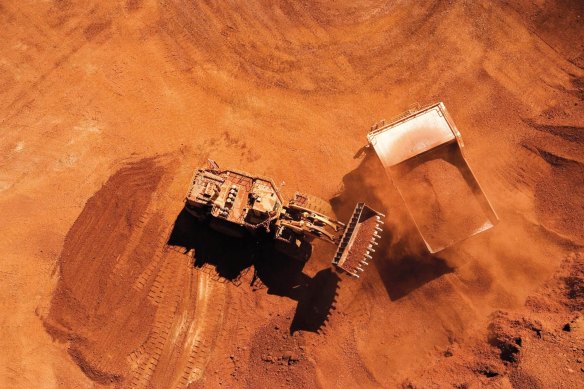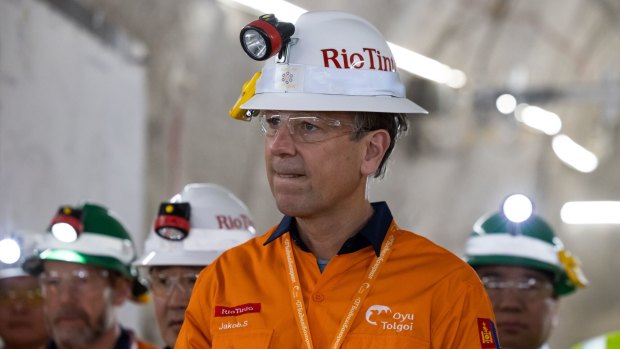By Simon Johanson and Jesinta Burton
Mining giant Rio Tinto and Australia’s richest woman, Gina Rinehart, may each face an estimated hit of $1.22 billion in royalty payments if the descendants of prospector Peter Wright win a high-stakes civil case under way in Perth over income from the Hope Downs iron ore discoveries.
The descendants of two business partners of Lang Hancock, Rinehart’s father, want to claw back billions of dollars in iron ore royalties from Rinehart’s Hancock Prospecting in the West Australian Supreme Court case, but the proceeding may also drag in Hope Downs’ joint partner Rio Tinto.

A 1.25 per cent royalty stake in the proceeds of the Hope Downs mines from first production of iron ore in 2007 to date would amount to $1.22 billion after factoring in interest of 5 per cent.Credit:
An analysis of the potential financial impact, requested by this masthead and undertaken by an investor services firm, has for the first time put a dollar figure on the accumulated potential liability Hancock Prospecting and Rio Tinto may separately face.
A 1.25 per cent royalty stake in the proceeds of the Hope Downs mines from first production of iron ore in 2007 to date would amount to $1.22 billion after factoring in interest of 5 per cent, the analysis estimates.
Testimony in court so far has been dominated by the descendants of prospector Peter Wright and the family of another often-forgotten prospector, Don Rhodes, who have outlined their claims.
Wright Prospecting claims the Hope Downs tenement in the Pilbara – discovered by the school friends turned business partners Hancock and Wright, and home to four operational mines owned by Rinehart’s Hancock Prospecting and Rio Tinto – was held jointly under a 1980s partnership deed. Wright Prospecting is seeking its half of the 2.5 per cent royalty from the combined mine’s output.
Rhodes’ family company, DFD Rhodes, has insisted the critical role Rhodes played in discovering the mammoth iron ore deposit entitled him to a 1.25 per cent stake of the proceeds from the “Hanwright” partnership.
At the heart of Wright Prospecting’s claim is the argument that both it and Hancock Prospecting were supposed to share equally in the spoils of any Hanwright partnership assets developed under deals inked between 1978 and 1987, including Hope Downs – which hasn’t happened.
Mining giants BHP, Fortescue Metals Group and Rio earned record prices for cargoes of iron ore in 2021, shipping huge volumes of the raw material from the Pilbara that was smelted in steel furnaces around the world to create molten pig iron.
That made iron ore Australia’s most lucrative commodity and provided more than $120 billion in export earnings over the past financial year alone. Rio operates the four Hope Downs mines and is Australia’s largest iron ore exporter.

Jakob Stausholm, chief executive of Rio Tinto Group.Credit: Bloomberg
The company’s potential liability, if any, in the Supreme Court case is still unclear. However, Wright Prospecting’s lawyer Julie Taylor told the court a week ago that a deed signed before the announcement of the joint Venture between Rio and Hancock Prospecting incorporated rules for how that “liability” was to be met, with Hancock and Rio Tinto assuming “joint responsibility”.
Taylor said that Hancock Prospecting’s subsidiary discussed royalty payments with Rio in the lead-up to the 2005 agreement. She told the court there was a list of assumed liabilities which included paying compensation if there was a failure to pay royalties to Wright or Rhodes on the iron ore sold, and that both parties would assume liability for that jointly.
When asked this week if Rio was aware of any potential financial impact from the proceedings, chief executive Jakob Stausholm said: “I don’t think so. We are an observer in the dispute and we’ll have to see how it unfolds.
“I mean, I would love to say no, but I don’t know how things are unfolding in the courtroom.”
A Rio Tinto spokesman on Thursday played down the prospect of the miner making a hefty royalty payment.
“The suggestion that Rio Tinto could be liable for $1.2 billion as a potential outcome of this litigation is inaccurate,” the spokesman said.
Neither the descendants of Peter Wright nor Don Rhodes have given an estimate of the total sum that may be due if the court finds in their favour, but the court is likely to consider evidence from forensic accountants at some point to determine any amount.
It is understood a separate trial would be held for the parties to argue over how much and who should pay if Wright and Rhodes win. The proceedings are ongoing.
The Business Briefing newsletter delivers major stories, exclusive coverage and expert opinion. Sign up to get it every weekday morning.